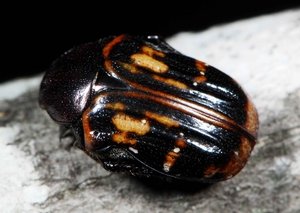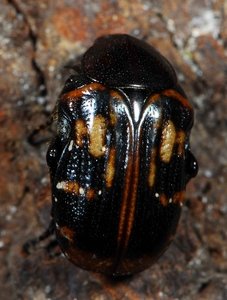brown beetle

 on 3rd November 2012
on 3rd November 2012
about 1 cm long
Other observations of Variable Fruit Chafer (Elaphinis delagoensis)
Comments
Elaphinis
My money is on Elaphinis sp.
Elaphinis!?
You know what, I'll check out this idea. Fortunately I am still at work (= S.A. National Collection of Insects), but it seems to be after-hours now, so I can spend some time on this observation. It has been bothering me big time.
Usually (98-99% of the time), Elaphinis individuals have a matt [?matte] upper surface and are not shiny, but they are extremely variable in their colour pattern [see link], and there is that one or two percent of specimens which are glossy.
Keep in mind that the three specimens at the above link [as of tonight] were all photographed at the same place and on the same day as the present delinquent observation. Are they all four the same??
So here I am, off to the chafer cabinets. Update soon ...
-- Beetledude
Talking to myself
It is a real pain that this beetle's head, legs and pygidium are not visible.
Just now jackals called. My office building is on a farm.
-- Beetledude
Not talking to yourself
I'm listening. I see what you mean about the glossiness compared to the other Elaphinis. But ignoring that, it looks so close.
Yes, it would be good to see the head, which is clearly visible on the other Elaphinis, which makes me think perhaps it isn't E.
Oh well.
Jackals? Good heavens.
Talking to myself and to Vynbos
Jackals close by now. But they move a lot. The sheep are not safe here.
- Only now that I have zoomed in substantially I saw that this beetle has a few cretaceous spots [white, chalky marking] on its dorsum, and is not entirely without.
-
.
- I am worried that this beetle's humeral arches [where the elytra are cut out at the sides to show part of the thorax and the base of the hindlegs when viewed from above] are too deep for Elaphinis.
-
.
- Looking at real specimens, I have now discovered that not only the colouration, but also the sculpture [grooves, ridges, pits, etc.] of Elpahinis are very variable. At first I thought this beetle's dorsal sculpture is too different from the other existing Elpahinis delagoensis observations to be the same.
.
-- Beetledude
Talking to myself (with Riaan in earshot)
(History has shown that when I say 'my money is on XYZ,' everyone else knows that they can now exclude XYZ as a possible ID. I wonder if I should break this to Riaan?)
<strong>vynbos, jou doring!</strong>
I have located two glossy Elaphinis delagoensis specimens. They look like completely different beasts, but both have been reliably identified. The one from Chuniespoort has the subhumeral arches as deeply excavated as the beetle in this observation, and its dorsal sculpture is almost exactly like that of the mystery chafer here. It is a pitch black specimen. The other glossy specimen, from Hluhluwe, has its colours patterned differently from the mystery chafer, but its dorsal colours are exactly the same as here: very dark brown, almost black, but still brown; with flavous patches of a foxy orange graduating to a yellowish fawn. Both glossy specimens have a couple of small, discrete cretaceous spots, just like the beetle in this observation, although the arrangement of these spots are different among all three specimens.
So far, so good.
Despite his recent self-doubting and talking to himself besides, it was vynbos who lead me to evaluate the mystery beetle here as possibly an Elaphinis species, something I did not consider previously. So I consulted the Blue Book** ::
Among the critical generic characteristics of Elaphinis there are these:
- Scutellum with lateral margins concave; scutellum longer than wide, with its apex rounded. YES..
- Elytra clearly with three longitudinal ridges. YES.
- Areas between the elytral ridges with double rows of punctate striae. YES. With some imagination.
- Subhumeral arch deep. YES.
- Elytral sides diverging behind subhumeral arch. YES.
- Anterior pronotal margin with a rounded median tubercle. YES. Visible in second picture..
.
The verdict: This is a species of the fruit chafer genus Elaphinis.
Recommendation: vynbos, take up your bed and please add the identification that you are responsible for in the ID box, above. Two species of Elpahinis can reasonably be expected in the Kruger National Park [this observation], namely the so-called Variable Fruit Chafer (Elaphinis delagoensis), and the smaller Elaphinis pumila. The latter species was considered "possibly extinct" by Holm & Marais (1992); it is at least extremely rare or extremely elusive, and has not been recollected since the 19th century.
Then I shall "I agree!" with a confident click, and go home.
.
Thank you for the puzzle of these four observations, Peter Webb. It was a good challenge.
.
** The Blue Book (Holm & Marais 1992) is called the Blue Book for two reasons: It is a blue book; and there are very many drawings of genitalia in the book.
-- Beetledude
Well done, Riaan!
I think this is the first time my hunch has been correct, and it was this observation that made me think Elaphinis. Turns out it's not just the same genus, but the same species! Yay.
Thanks Riaan.
Now watch out for the jackals while walking to your car.
Helluva Variable Fruit Chafer
I think would be a good common name.
Original ID
Link to Riaan's original analysis of these 4 Kruger Nat Park Chafers:
Wow




I am so impressed with your guys dedication and samewerking. And I'm still chuckling at some of the comments. This site rocks, and so do you.
Rock on!
---
Tritonia Gallery






Cremastocheilini ??
Cremastocheilini ??
-- Beetledude